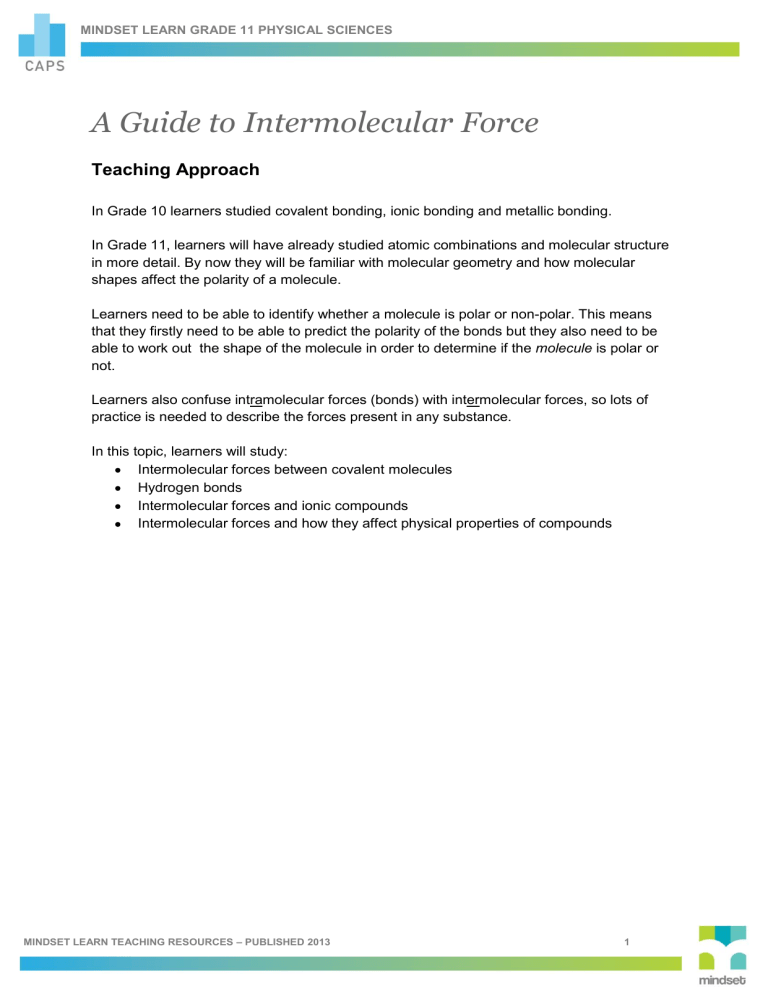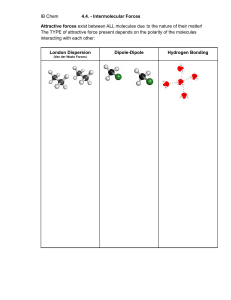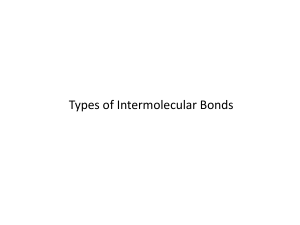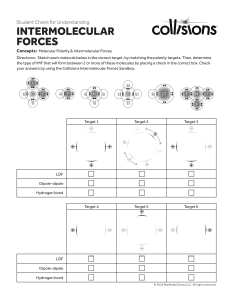
MINDSET LEARN GRADE 11 PHYSICAL SCIENCES A Guide to Intermolecular Force Teaching Approach In Grade 10 learners studied covalent bonding, ionic bonding and metallic bonding. In Grade 11, learners will have already studied atomic combinations and molecular structure in more detail. By now they will be familiar with molecular geometry and how molecular shapes affect the polarity of a molecule. Learners need to be able to identify whether a molecule is polar or non-polar. This means that they firstly need to be able to predict the polarity of the bonds but they also need to be able to work out the shape of the molecule in order to determine if the molecule is polar or not. Learners also confuse intramolecular forces (bonds) with intermolecular forces, so lots of practice is needed to describe the forces present in any substance. In this topic, learners will study: Intermolecular forces between covalent molecules Hydrogen bonds Intermolecular forces and ionic compounds Intermolecular forces and how they affect physical properties of compounds MINDSET LEARN TEACHING RESOURCES – PUBLISHED 2013 1 MINDSET LEARN GRADE 11 PHYSICAL SCIENCES Video Summaries Some videos have a ‘PAUSE’ moment, at which point the teacher or learner can choose to pause the video and try to answer the question posed or calculate the answer to the problem under discussion. Once the video starts again, the answer to the question or the right answer to the calculation is given Mindset suggests a number of ways to use the video lessons. These include: Watch or show a lesson as an introduction to a lesson Watch or show a lesson after a lesson, as a summary or as a way of adding in some interesting real-life applications or practical aspects Design a worksheet or set of questions about one video lesson. Then ask learners to watch a video related to the lesson and to complete the worksheet or questions, either in groups or individually Worksheets and questions based on video lessons can be used as short assessments or exercises Ask learners to watch a particular video lesson for homework (in the school library or on the website, depending on how the material is available) as preparation for the next day’s lesson; if desired, learners can be given specific questions to answer in preparation for the next day’s lesson 1. Intermolecular Forces: Revision In this lesson we revise the covalent bonding, covalent molecules as well as the polar and non-polar covalent molecules concepts. The difference between intra-molecular forces and inter-molecular forces is also briefly discussed. 2. Intermolecular Forces between Covalent Molecules In this lesson, the intermolecular forces known as the Van der Waals forces involved with covalently bonded substances are studied. These include; London forces, dipole-induced dipole forces, dipole-dipole forces. 3. Hydrogen Bonds In this lesson, hydrogen bonds are studied. The lesson proceeds then to explain some of the physical properties of water that can be attributed to hydrogen bonds. 4. Intermolecular Forces and Ionic Compounds In this lesson, the intermolecular forces involving ionic compounds are studied. These include ion-dipole forces, ion-induced dipole forces. 5. Intermolecular forces and Physical Properties This lesson looks at the relationship between intermolecular properties and the physical properties of compounds. 6. Practical Demonstrations of Intermolecular Forces This lesson contains practical demonstrations of all the properties of substances related to their intermolecular forces that were discussed in the last lesson. MINDSET LEARN TEACHING RESOURCES – PUBLISHED 2013 2 MINDSET LEARN GRADE 11 PHYSICAL SCIENCES Resource Material 1. Intermolecular Revision 2. Intermolecular between Molecules Forces: Forces Covalent 3. Hydrogen Bonds 4. Intermolecular Forces and Ionic Compounds 5. Intermolecular Forces and Physical Properties 6. Practical Demonstrations of Intermolecular Forces http://www.chemguide.co.uk/atoms/ bonding/covalent.html A description of the covalent bond and examples. http://users.stlcc.edu/gkrishnan/pol ar.html The difference between polar and non-polar molecules, with examples. http://www.chemguide.co.uk/atoms/ bonding/vdw.html This page explains the origin of the two weaker forms of intermolecular attractions - van der Waals dispersion forces and dipole-dipole attractions. http://en.wikipedia.org/wiki/Van_der _Waals_force A description of Van der Waals forces. http://www.chemguide.co.uk/atoms/ bonding/hbond.html Explains the origin of hydrogen bonding with a range of examples. http://www.elmhurst.edu/~chm/vche mbook/161Ahydrogenbond.html Explains the origin of hydrogen bonding with a range of examples. https://www.boundless.com/chemist ry/liquids-and-solids/intermolecularforces/ion-dipole-force/ Description of ion-dipole forces https://www.chem.unsw.edu.au/cou rsenotes/CHEM1/nonunipass/haine sIMF/iondipole.html Description of ion-induced dipole forces http://www.chemguide.co.uk/atoms/ structures/molecular.html This page describes how the physical properties of substances with molecular structures varies with the type of intermolecular attractions - hydrogen bonding or van der Waals forces. http://www2.chemistry.msu.edu/fac ulty/reusch/virttxtjml/physprop.htm A resource on intermolecular forces. http://maimelatct.files.wordpress.co m/2014/02/physicalsciences-grade11-term-1-1.pdf Not only is this a wonderful set of notes and other resources for all of Grade 11 Term 1 (lesson plans) from Chipa Maimela, but it also provides a pointer to the kind of experiment to do for capillarity: Investigate and explain the effects of intermolecular forces on evaporation, surface tension, solubility, boiling points and MINDSET LEARN TEACHING RESOURCES – PUBLISHED 2013 3 MINDSET LEARN GRADE 11 PHYSICAL SCIENCES capillarity. Use the guidelines in Oxford Successful Physical Sciences Grade 11 p 95 and complete the five individual experiments in consecutive lessons. Learners can complete the write-up once all the experiments have been done. http://www.bozemanscience.com/a p-chem-018-intermolecular-forces/ This video provides a good summary of intermolecular forces and their effects on the properties of substances. Capillarity, which is not covered in lesson 6, is also mentioned. https://www.youtube.com/watch?v= yw3KsRRbIf4 This short video gives a very clear view of capillarity, although it does not explain it or compare capillarity in different substances. http://www.tutorvista.com/content/p hysics/physics-iii/solids-andfluids/capillarity.php Some simple examples of how capillarity works in everyday examples like candle wicks and wet towels. MINDSET LEARN TEACHING RESOURCES – PUBLISHED 2013 4 MINDSET LEARN GRADE 11 PHYSICAL SCIENCES Task Question 1 State whether the following covalent molecules are polar or non-polar: 1.1 BI3 1.2 H2O 1.3 NH3 1.4 CH4 1.5 CO2 Question 2 Which of the following compounds will experience London forces between their molecules? H2O; Cl2, Ar; PH3; BF3; HCl; CH4 Question 3 Methanol, CH3OH, is found in methylated spirits and can be used as a fuel. Methanol is found as a liquid at room temperature. The methanol molecule is not much larger than the methane molecule, CH4. However, methane is a gas at room temperature. Explain why this is so. Question 4 Explain why an iceberg floats on the surface of the water and does not sink. Question 5 Arrange the following substances in order of increasing boiling point: H2O; CO; H2 Question 6 Why does sodium chloride (NaCl) dissolves easily in water but hardly at all in carbon tetrachloride (CCl4)? Question 7 Which of the following pairs of substances: HCl and CO; NaCl and CCl4; KBr and H2S; CCl4 and Br2 7.1 Interact with one another via ion-dipole forces? 7.2 Interact with one another via dipole-dipole forces? 7.3 Interact with one another via ion-induced dipole forces? 7.4 Interact with one another via induced dipole-induced dipole forces? Question 8 Which substance would you expect to have a higher boiling point out of N2 and Br2? Explain. Question 9 If you had a sample of solid bromine (Br2(s)) and you dropped it into some liquid bromine (Br2(l)), would it float or sink? Explain. MINDSET LEARN TEACHING RESOURCES – PUBLISHED 2013 5 MINDSET LEARN GRADE 11 PHYSICAL SCIENCES Question 10 Which substance will have the higher boiling point, NO or Ne? Explain. Question 11 Metallic joints in the road such as that shown in this diagram are often seen on roads and bridges. Explain what their purpose is. MINDSET LEARN TEACHING RESOURCES – PUBLISHED 2013 6 MINDSET LEARN GRADE 11 PHYSICAL SCIENCES Task Answers Question 1 1.1 Non-polar 1.2 Polar 1.3 Polar 1.4 Non-polar 1.5 Non-polar Question 2 Cl2, Ar, CH4 Question 3 Methanol is polar and will experience dipole-dipole intermolecular forces. Methanol is non-polar and will experience weak London forces between the molecules. Dipole-dipole forces are stronger than London forces. As a result more energy is required to break apart the molecules of methanol. Therefore methanol has a higher boiling point than methane. Question 4 The lattice of water molecules occupies a greater volume when in the solid phase than in the liquid phase. This is as a result of the hydrogen bonding within the water molecules, combined with the nonlinear shape of the water molecules. Thus, water is less dense in the solid phase than in the liquid phase, so ice floats on water. Question 5 H2 (Van der Waals; London forces) ; CO (Van der Waals; dipole-dipole forces) ; H2O (Hydrogen bonds) Question 6 + - NaCl dissolves in water because NaCl is ionic and dissociates into ‘polar’ Na and Cl ions when dissolved in water. Water is polar and so NaCl will dissolve because of ion-dipole forces. However, CCl4 is non-polar, so NaCl cannot dissolve in it. Question 7 7.1 7.2 7.3 7.4 KBr and H2S HCl and CO NaCl and CCl4 CCl4 and Br2 Question 8 Br2. molecules are larger, therefore stronger intermolecular forces, therefore higher boiling point. Question 9 It would sink. Molecules in a solid are packed closer together than in a liquid and are therefore more dense, so will sink when placed in the liquid. Question 10 NO. NO molecules are polar whilst atoms of Ne are non-polar. Therefore intermolecular forces are stronger in NO than in Ne. Molecules of NO are more difficult to break apart, therefore boiling point will be higher. MINDSET LEARN TEACHING RESOURCES – PUBLISHED 2013 7 MINDSET LEARN GRADE 11 PHYSICAL SCIENCES Question 11 As the temperature of the road increases, the molecules in the tar will expand. The joint is there in the road to allow for this expansion, otherwise the road may crack or get bumps in it. MINDSET LEARN TEACHING RESOURCES – PUBLISHED 2013 8 MINDSET LEARN GRADE 11 PHYSICAL SCIENCES Acknowledgements Mindset Learn Executive Head Content Manager Classroom Resources Content Coordinator Classroom Resources Content Administrator Content Developer Content Reviewers Dylan Busa Jenny Lamont Helen Robertson Agness Munthali Candace Rennie Ross Moore Liz Harris Produced for Mindset Learn by Traffic Facilities Coordinator Production Manager Director Editor Presenter Studio Crew Graphics Cezanne Scheepers Belinda Renney Alriette Gibbs Belinda Renney Banji Longwe Abram Tjale James Tselapedi Wilson Mthembu Kieron Clarke Credits https://static.newworldencyclopedia.org/7/7c/Johannes_Diderik_van_der_Waals.jpg http://commons.wikimedia.org/wiki/File:Caribbean_sea_-_Morrocoy_National_Park_-_Playa_escondida.jpg http://upload.wikimedia.org/wikipedia/commons/d/de/Nacl-structure.jpg http://upload.wikimedia.org/wikipedia/commons/c/cc/SpiritTherm02.jpg http://upload.wikimedia.org/wikipedia/commons/2/20/BridgeExpansionJoint.jpg This resource is licensed under a Attribution-Share Alike 2.5 South Africa licence. When using this resource please attribute Mindset as indicated at http://www.mindset.co.za/creativecommons MINDSET LEARN TEACHING RESOURCES – PUBLISHED 2013 9





